Original - Odaily
Author-husband how

CEX, which represents centralization, and Web3 wallet, which represents decentralization, are indispensable tools for most people to participate in the crypto market. In recent years, the boundaries between the two have gradually blurred.
Exchanges led by OKX create built-in Web3 wallets. After depositing funds, users can participate in on-chain activities without transferring money to other on-chain wallets; wallets represented by MetaMask integrate deposit and withdrawal channels into their own wallets, providing Users have access to the full-process business model.
Of course, there are also some centralized exchanges that adopt the method of acquiring or self-developed Web3 wallets. For example, Binance acquired Trust Wallet in 2018, Bitget acquired BitKeep in March this year, and Coinbase launched Coinbase Wallet.
No matter which way the above projects are laid out, they are all trying to seize the future Web3 traffic position.
Recently, Binance, the leading centralized exchange, has launched grayscale testing for the exchange’s built-in Web3 wallet. How is the test going? Odaily explored this.
Binance Web3 wallet received mediocre response, but TWT broke new highs?
On November 3, based on feedback from the crypto community, the Web3 wallet built into the Binance App invited some users to start a grayscale test. (Odaily Note: Grayscale testing refers to selecting a specific group of people to try out an application before it is officially released, and gradually expanding the number of trial users so that problems can be discovered and corrected in a timely manner)
Binance Web3 Wallet is a self-hosted crypto wallet in the Binance App that aims to lower the threshold for users to enter the world of decentralized finance (DeFi). As a digital gateway for blockchain-based applications (dApps), it provides users with a secure and streamlined way to manage their cryptocurrencies, perform token transactions across chains, earn yields, and interact with various on-chain Ecological platform for interaction.
Binance Web3 Wallet uses MPC (Multi-Party Secure Computing) technology to manage every transaction, reducing the possibility of single points of failure. Moreover, the Binance Web3 wallet uses a complex security mechanism that will generate three independent key shares and store them separately in locations including your personal cloud and device; at least two key shares are required to access the Binance wallet. There are also other enhanced security features, such as wrong address protection and malicious contract detection, which will notify users of whether there are security risks in their tokens and links during transactions.
So, what is the feedback from early test users on this grayscale test?
Odaily search found that the communitys feedback on the Binance Web3 wallet was relatively lackluster. Some people who had tested it expressed on social media that the private key could not be exported. However, after testing by the author, the Binance Web3 wallet currently functions normally. Users only need to download Google Drive to create a wallet key. Since the Binance Web3 wallet is still in the early testing stage and the related supporting facilities are not yet complete, the author cannot share more evaluation experience.
Affected by the news that Binance is testing a built-in Web3 wallet, Trust Wallet, another wallet project related to Binance, has become the focus of speculation in the past few days, and its price has increased significantly. The project was acquired by Binance in 2018. The reason for the increase may be related to the sentiment spread by the community that Trust Wallet helps Binance develop a Web3 wallet.
Bitget quotes show that the Trust Wallet token TWT soared from 1.1 USDT on November 3 to a maximum of 1.55 USDT, a new high since mid-February this year; it is temporarily trading at 1.46 USDT, with a 24-hour increase of 9.4%.

The boundaries between Web2 and Web3 are gradually blurring
The boundaries between centralization and decentralization are gradually becoming blurred in todays development. Centralized exchanges have deployed Web3 wallets, and Web3 wallets have opened up the boundaries with reality. The ultimate goal of both is to retain user traffic in their own systems.
Binance relies on the huge traffic of its own exchange, coupled with Trust Wallet and App built-in wallet, to fully cover users Web3 activities.
However, after all, Binance’s built-in wallet has just been born and is small in scale. On the other hand, OKX Web3 wallet is now relatively mature, especially in the Bitcoin ecosystem to seize the first-mover advantage. OKX CEO Star also said that in the future, OKX Web3 wallet may become Standalone application.
All in all, whether it is centralized exchanges led by Binance and OKX, or Web3 wallets led by MetaMask, they are working hard to break the boundaries between old and new networks and make it easier for new users to enter Web3.










